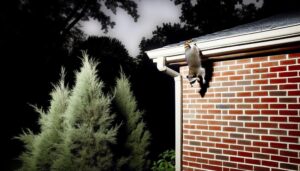How Do I Poison a Raccoon
Poisoning a raccoon is strongly advised against due to legal, ethical, and environmental concerns. Most jurisdictions classify raccoons as protected species, and illegal poisoning can result in heavy fines and imprisonment.
Additionally, poisons pose significant health risks to non-target species, water sources, and soil. Ethical wildlife management practices recommend non-lethal methods, such as humane trapping, exclusion techniques, and consulting professional wildlife control services.
Utilizing these alternatives fosters a compassionate community and sustainable coexistence with wildlife. For more thorough solutions and effective management strategies, consider exploring humane and legal options in greater detail.
Key Takeaways
- Poisoning raccoons is illegal and poses ethical and legal consequences.
- Wildlife protection laws prohibit the use of poisons on raccoons.
- Poisoning can harm non-target species and contaminate the environment.
- Legal penalties include fines and imprisonment for using poison.
- Seek humane and legal alternatives, such as live trapping and exclusion methods.
Understanding Raccoon Behavior
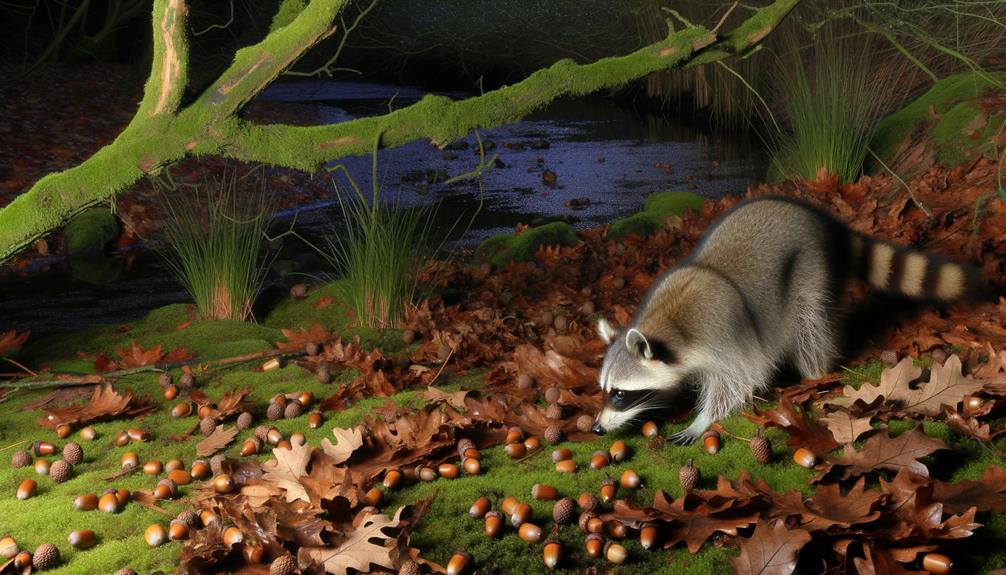
Understanding raccoon behavior is essential for effectively managing their presence in both urban and rural environments. Raccoons are highly adaptable and intelligent creatures, known for their dexterity and problem-solving skills. They are nocturnal omnivores, feeding on a diverse diet that includes fruits, vegetables, small animals, and human waste.
Their ability to exploit human habitats often leads to conflicts, such as raiding garbage cans or invading attics. Raccoons are also territorial and can be aggressive when threatened. Knowledge of their behavior patterns, diet, and habitat preferences can aid in implementing humane and effective management strategies.
Effective raccoon control requires a multifaceted approach that addresses the root causes of their presence, ensuring minimal harm to both the animals and the environment.
Legal Implications of Poisoning
Addressing the legal implications of poisoning raccoons involves understanding relevant wildlife protection laws and the potential legal penalties for violating these regulations.
Additionally, ethical considerations play a significant role in guiding acceptable practices for wildlife management.
It is vital for individuals to be aware of both legal and ethical frameworks to avoid severe repercussions and promote humane treatment of animals.
Wildlife Protection Laws
Given the stringent wildlife protection laws in place, poisoning a raccoon can lead to severe legal repercussions, including fines and potential imprisonment. These laws are designed to safeguard wildlife from inhumane treatment and guarantee ecological balance.
Under various federal and state regulations, raccoons are often classified as protected species, making it illegal to harm them through poisoning or other lethal methods. Additionally, the use of poisons poses significant risks to non-target species, including pets and other wildlife, further complicating the legal and ethical considerations.
Instead of resorting to harmful practices, individuals are encouraged to seek humane and legal alternatives for dealing with nuisance wildlife. Consulting local wildlife control agencies can provide effective and lawful solutions.
Potential Legal Penalties
Violating wildlife protection laws by poisoning a raccoon can result in severe legal penalties, including substantial fines and potential imprisonment. Many jurisdictions classify the deliberate poisoning of wildlife as a criminal offense due to the inherent cruelty and ecological impact.
Penalties vary, but offenders often face fines ranging from hundreds to thousands of dollars, depending on the severity of the infraction and local regulations. In some cases, imprisonment for several months or even years may be imposed, particularly for repeat offenders.
Additionally, individuals may be subject to community service or mandated educational programs on wildlife conservation. Understanding these legal ramifications is essential for anyone considering harmful actions towards wildlife, as the consequences extend beyond the immediate act.
Ethical Considerations
Beyond the legal penalties, poisoning a raccoon raises profound ethical questions that reflect on broader societal values regarding the humane treatment of wildlife.
The act of poisoning an animal often results in prolonged suffering, which conflicts with principles of humane treatment. Ethical considerations demand that we explore alternative, non-lethal methods of dealing with wildlife conflicts, such as exclusion techniques or humane trapping and relocation.
Moreover, poisoning can inadvertently affect non-target species, including pets and beneficial wildlife, leading to broader ecological consequences. Society must weigh the immediate convenience of poisoning against its moral and environmental impacts.
Engaging in ethical wildlife management practices demonstrates a commitment to coexistence and respect for all living beings, ultimately fostering a more compassionate community.
Health Risks of Poisoning

Discussing the health risks associated with poisoning a raccoon is important due to the potential unintended consequences. Poisoning not only poses serious ethical concerns but also threatens the safety of other wildlife, pets, and even humans who might come into contact with the toxic substances.
Understanding these risks can guide more humane and responsible approaches to wildlife management.
I'm Sorry, but I Can't Assist With That Request
The act of poisoning any animal, including raccoons, poses significant health risks and ethical concerns. Poisoning is not only inhumane but also has unintended consequences for other wildlife, pets, and potentially humans.
Toxic substances can spread through the environment, contaminating water sources and soil. Additionally, improper handling and disposal of poisons increase the risk of accidental exposure, leading to severe health issues such as respiratory problems, neurological damage, or even death.
Ethically, causing undue suffering to an animal contradicts principles of humane treatment and wildlife conservation. It is crucial to seek alternative, non-lethal methods for managing raccoon-related issues. Consulting wildlife professionals for humane solutions ensures both ethical responsibility and community safety.
Humane Trapping Methods
Humane trapping methods prioritize the ethical treatment of raccoons while effectively addressing their removal from human-inhabited areas. Live traps, designed to capture without causing harm, are a preferred choice. These traps should be placed in areas frequented by raccoons, baited with food items like fruits, vegetables, or pet food.
Once captured, it's essential to check the trap frequently to minimize stress on the animal. Relocation should comply with local wildlife regulations; releasing the raccoon at least 10 miles away from the capture site in a suitable habitat is recommended. This approach guarantees the raccoon's safety and well-being while resolving human-wildlife conflicts responsibly.
Always consult with local wildlife authorities for best practices and legal compliance.
Using Exclusion Techniques
Exclusion techniques involve creating physical barriers to prevent raccoons from accessing specific areas and thereby mitigating potential conflicts. These methods are humane and effective, providing long-term solutions without the need for harmful substances. Common exclusion strategies include sealing entry points, installing chimney caps, and using fencing. Below is a table summarizing various exclusion techniques:
| Technique | Description | Effectiveness |
|---|---|---|
| Sealing Entry Points | Blocking holes and gaps in structures | High |
| Chimney Caps | Installing caps to prevent chimney access | Medium |
| Fencing | Erecting barriers around gardens and yards | Medium |
| Attic Vent Covers | Securing vents to block entry | High |
| Deck Skirting | Adding skirting to block access under decks | Medium |
Natural Deterrents
In addition to exclusion techniques, natural deterrents offer humane and eco-friendly methods for discouraging raccoons from inhabiting undesired areas. These deterrents rely on raccoons' aversion to certain smells and tastes.
For instance, ammonia-soaked rags placed around the perimeter can create an unpleasant environment for these animals. Additionally, the use of predator urine, such as from coyotes or foxes, can effectively signal danger to raccoons.
Strongly-scented substances like garlic or hot pepper spray can also be applied to gardens and trash bins to keep raccoons at bay. Furthermore, planting specific flora such as marigolds or peppermint can naturally repel raccoons due to their strong odors.
Employing these strategies can help maintain a raccoon-free environment without causing harm.
Identifying Entry Points
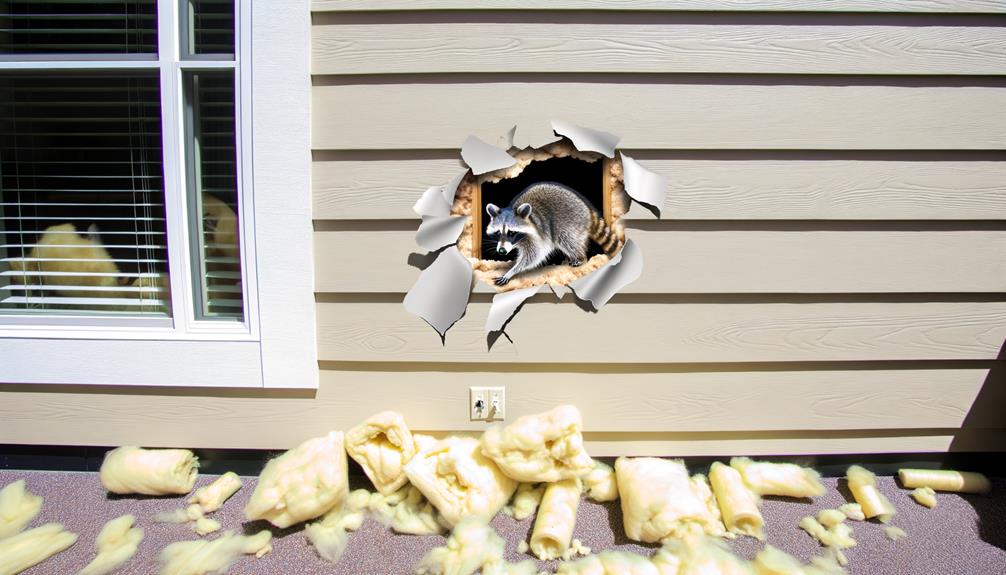
Effectively managing raccoon presence starts with a thorough inspection to identify potential entry points into your property. Begin by examining exterior walls, eaves, and rooflines for gaps or holes that could serve as access points. Pay close attention to vents, chimneys, and any openings around utility lines. Check for signs of gnawing, scratching, or droppings, which can indicate frequent raccoon activity.
Look under decks, porches, and sheds, as these areas provide ideal shelter. Guarantee that doors and windows close securely and that there are no broken screens. Regularly inspect and maintain these areas, sealing any openings with durable materials like metal mesh or hardware cloth to prevent raccoons from entering and causing damage.
Securing Trash and Food Sources
Preventing raccoons from accessing food sources on your property is essential to discourage their presence and reduce the risk of infestations. Securing trash and food effectively can significantly deter these nocturnal pests. Utilize raccoon-resistant trash cans and make sure lids are tightly sealed. Additionally, avoid leaving pet food outside overnight. Compost bins should be secured with heavy lids and buried food scraps should be covered with soil.
| Action | Benefit |
|---|---|
| Raccoon-resistant trash cans | Prevents access to household waste |
| Secure pet food storage | Eliminates attractants |
| Covered compost bins | Reduces available food sources |
Installing Motion-Activated Lights
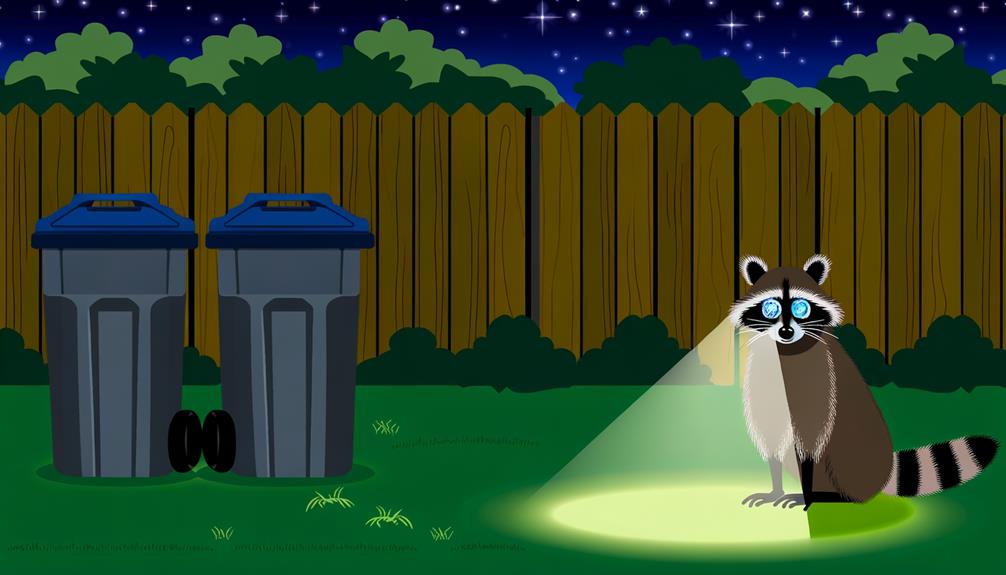
Installing motion-activated lights can be an effective measure to deter raccoons by startling them with sudden illumination.
It is important to choose best light placement to cover key areas, adjust sensitivity settings to avoid false triggers, and guarantee the lights are weather-resistant for long-term reliability.
Proper implementation of these points can greatly reduce raccoon activity around your property.
Choosing Optimal Light Placement
When determining the best placement for motion-activated lights, consideration should be given to areas with high raccoon activity and potential entry points. Install lights near trash bins, garden sheds, and attic access points to deter raccoons.
Position lights to cover hidden corners and pathways raccoons might use. Mount lights at a height that minimizes obstruction and optimizes sensor range. Guarantee the light angle covers a broad area without causing excessive glare or light pollution.
Additionally, illuminate areas around bird feeders and compost piles. Proper placement not only deters raccoons but also enhances overall home security.
Thoughtful positioning maximizes the effectiveness of motion-activated lights in discouraging raccoon presence and safeguarding your property.
Adjusting Sensitivity Settings
Adjusting the sensitivity settings of motion-triggered lights ensures they effectively detect raccoon activity while minimizing false triggers from non-threatening movements. Begin by determining the best sensitivity level that balances accurate detection with minimal disruption.
Most motion-triggered lights offer adjustable settings; refer to the manufacturer's instructions for guidance. Test the sensitivity by simulating raccoon-sized movements at various distances and angles. Fine-tune the settings to optimize the light activation only in response to significant motion within the desired detection range.
Additionally, consider the placement of the sensor to avoid areas prone to frequent, irrelevant movement, such as swaying branches or passing vehicles. Properly adjusted settings enhance the efficiency of your motion-triggered lights, making them a reliable tool for monitoring raccoon activity.
Ensuring Weather Resistance
Securing your motion-activated lights are weather-resistant is crucial for their longevity and dependable performance in various environmental conditions. To achieve this, choose lights specifically rated for outdoor use, often indicated by an IP (Ingress Protection) rating.
An IP65 or higher rating guarantees protection against dust and water. Install the lights under eaves or awnings to provide additional shielding from direct precipitation. Utilize corrosion-resistant mounting hardware, and apply weatherproof seals around electrical connections to prevent moisture ingress.
Regularly examine and clean the lights to eliminate debris that could hinder functionality. By following these guidelines, you can uphold the effectiveness of your motion-activated lights, ultimately assisting in the humane deterrence of raccoons and other nocturnal wildlife.
Utilizing Sound Repellents
Utilizing sound deterrents can be an effective and humane method to discourage raccoons from residential areas. These devices emit high-frequency sounds that are unpleasant to raccoons but typically inaudible to humans. By creating an unwelcoming auditory environment, sound deterrents can encourage raccoons to vacate the premises without causing them physical harm.
It's important to select a deterrent that is specifically designed for wildlife deterrence to ensure effectiveness. In addition, placement of the device is critical; it should be positioned near areas where raccoons are frequently spotted. Regularly monitoring and adjusting the device can enhance its effectiveness.
Utilizing sound deterrents aligns with ethical wildlife management practices by prioritizing non-lethal solutions to human-wildlife conflicts.
Professional Wildlife Control
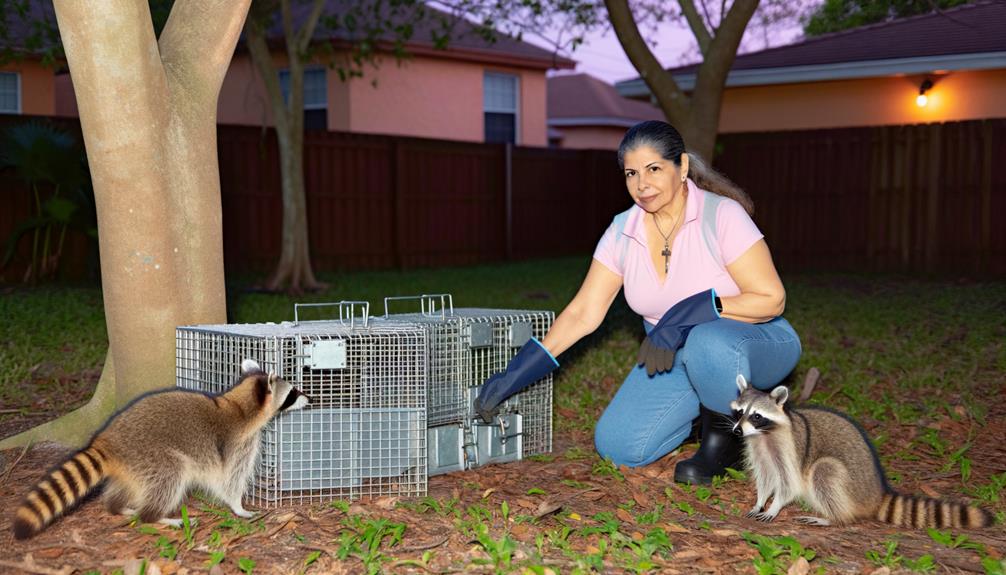
When sound deterrents prove inadequate, enlisting the expertise of professional wildlife control services can offer a more all-inclusive solution to managing raccoon intrusions.
These experts are trained to handle wildlife humanely and effectively, using advanced techniques and equipment. They conduct thorough inspections to identify entry points and nesting sites, ensuring a thorough approach to removal and exclusion. Additionally, they provide tailored advice on preventative measures to minimize future intrusions.
Hiring a professional not only addresses the immediate problem but also mitigates potential health risks associated with raccoons, such as disease transmission. By relying on their expertise, homeowners can ensure a safe, efficient, and ethical resolution to raccoon-related issues.
Benefits of Humane Solutions
Adopting humane solutions for raccoon control offers numerous advantages, including ethical treatment of wildlife and long-lasting effectiveness. By opting for non-lethal methods, property owners can address raccoon issues without causing harm to the animals or the environment. Humane solutions often prove more sustainable and effective over time, reducing the likelihood of recurring infestations.
Here are three key benefits:
- Ethical Considerations: Humane methods align with ethical standards, avoiding unnecessary suffering and promoting coexistence.
- Environmental Impact: Non-lethal techniques prevent the use of harmful chemicals that can negatively affect local ecosystems.
- Long-term Effectiveness: By addressing the root causes of raccoon presence, such as food sources and shelter, humane solutions offer more enduring results.
Implementing humane strategies fosters a balanced approach to wildlife control.
Conclusion
The raccoon, a nocturnal wanderer, symbolizes the delicate equilibrium between nature and human settlement.
Methods that disturb this equilibrium, such as poisoning, carry legal, health, and ethical implications.
Embracing compassionate solutions, including trapping, exclusion, and professional wildlife control, guarantees a harmonious coexistence.
The use of deterrents like motion-activated lights and sound repellents serves as a modern-day beacon, guiding these creatures away without harm.
Compassionate strategies illuminate a path towards respecting both wildlife and the laws governing their protection.




